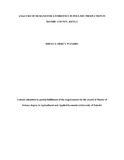| dc.description.abstract | Poultry production is an important economic activity for smallholder farmers in Kenya.
Commercial poultry farming in Kenya relies heavily on veterinary inputs, key among them being
antibiotics which develop resistance with improper use. Among the many interventions used in
the past to curb the risk of antibiotic resistance in livestock in Kenya, there is none that has
comprehensively addressed inappropriate use of antibiotics and the incentives driving their
demand in the livestock industry. This study, therefore,characterized antibiotic use patterns in
poultry production and assessed the responsiveness of antibiotic demand to factor and product
price changes in Kiambu County of Kenya. The aim was to generate information which can be
used to enrich policy design geared towards reducing the risk of antibiotic resistance in the
livestock sector in Kenya.
A sample of 238 commercial chicken farmers in Kiambu County was selected using a multistage
sampling procedure.Primary data were collected using semi-structured questionnaires.
Descriptive statistics were done to characterize the patterns of use for antibiotics. A normalized
restricted translog profit function was also used to estimate own-price and cross-price elasticity
of antibiotic demand in layer and broiler production systems in Kiambu County.Descriptive
statistics done to characterize the pattern of use for antibiotics indicated that: (i) antibiotics were
widely used in poultry production in Kiambu County, (ii) they were accessible to farmers,
mainly from agro-vet shops and (iii) Farmers administer antibiotics without the assistance of
professional veterinary personnel. The implication is that these practices increase the likelihood
of drug misuse and therefore the probability of increasing antibiotic resistance in poultry
for both layer and broiler production systems were negative, more than unity (-1.7 for broiler and
-1.2 for layers) and statistically significant (p<0.05), implying that manipulating antibiotic prices
is, potentially, an attractive strategy to control antibiotic use.On the other hand, the cross-price
elasticities of antibiotic demand were not statistically significant (p>0.05), implying that the cross
prices cannot be used as a strategy to regulate antibiotic use.Additionally, antibiotic demand was
positive and most sensitive to producer egg and chicken meat prices, which meant that most
farmers would use egg boosters and growth promoters with increased egg and chicken meat
prices.
The results indicated that rational use of antibiotics could be strengthened by the policy makers
manipulating antibiotic prices. Increasing the prices of antibiotics to reduce the demand through
an antibiotic “pigouvian” tax policy can achieve a significant reduction in antibiotic use. Also,
given the high and positive output price elasticities, farm output price support would be unlikely
to reduce antibiotic use in poultry production in Kiambu County.Therefore, supporting the
activities of the Pharmacy and Poisons Board and the Department of Veterinary Services in
monitoring and regulating the use of antibiotics as egg boosters in layers and growth promoters
in broilers is likely to reduce the overall risk of development of antibiotic resistance in poultry in
Kenya | en_US |

